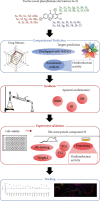Highly Accessible Computational Prediction and In Vivo/In Vitro Experimental Validation: Novel Synthetic Phenyl Ketone Derivatives as Promising Agents against NAFLD via Modulating Oxidoreductase Activity
- PMID: 36659905
- PMCID: PMC9844233
- DOI: 10.1155/2023/3782230
Highly Accessible Computational Prediction and In Vivo/In Vitro Experimental Validation: Novel Synthetic Phenyl Ketone Derivatives as Promising Agents against NAFLD via Modulating Oxidoreductase Activity
Abstract
Nonalcoholic fatty liver disease (NAFLD) has reached epidemic proportions with no pharmacological treatment approved. Several highly accessible computational tools were employed to predict the activities of twelve novel compounds prior to actual chemical synthesis. We began our work by designing two or three hydroxyl groups appended to the phenyl ketone core, followed by prediction of drug-likeness and targets. Most predicted targets for each compound overlapped with NAFLD targets (≥80%). Enrichment analysis showed that these compounds might regulate oxidoreductase activity. Then, these compounds were synthesized and confirmed by IR, MS, 1H, and 13C NMR. Their cell viability demonstrated that twelve compounds exhibited appreciable potencies against NAFLD (EC50 values ≤ 13.5 μM). Furthermore, the most potent compound 5f effectively prevented NAFLD progression as evidenced by the change in histological features. 5f significantly reduced total cholesterol and triglyceride levels in vitro/in vivo, and the effects of 5f were significantly stronger than those of the control drug. The proteomic data showed that oxidoreductase activity was the most significantly enriched, and this finding was consistent with docking results. In summary, this validated presynthesis prediction approach was cost-saving and worthy of popularization. The novel synthetic phenyl ketone derivative 5f holds great therapeutic potential by modulating oxidoreductase activity to counter NAFLD.
Copyright © 2023 Yanan Qiao et al.
Conflict of interest statement
The authors declare no conflicts of interest.
Figures






Similar articles
-
Investigation of the potential mechanism of the Shugan Xiaozhi decoction for the treatment of nonalcoholic fatty liver disease based on network pharmacology, molecular docking and molecular dynamics simulation.PeerJ. 2022 Nov 10;10:e14171. doi: 10.7717/peerj.14171. eCollection 2022. PeerJ. 2022. PMID: 36389420 Free PMC article.
-
Identify Molecular Mechanisms of Jiangzhi Decoction on Nonalcoholic Fatty Liver Disease by Network Pharmacology Analysis and Experimental Validation.Biomed Res Int. 2020 Dec 12;2020:8829346. doi: 10.1155/2020/8829346. eCollection 2020. Biomed Res Int. 2020. PMID: 33415161 Free PMC article.
-
Investigation of Lonicera japonica Flos against Nonalcoholic Fatty Liver Disease Using Network Integration and Experimental Validation.Medicina (Kaunas). 2022 Aug 30;58(9):1176. doi: 10.3390/medicina58091176. Medicina (Kaunas). 2022. PMID: 36143853 Free PMC article.
-
Insights into the molecular targets and emerging pharmacotherapeutic interventions for nonalcoholic fatty liver disease.Metabolism. 2022 Jan;126:154925. doi: 10.1016/j.metabol.2021.154925. Epub 2021 Nov 2. Metabolism. 2022. PMID: 34740573 Review.
-
Biological Mechanisms and Related Natural Inhibitors of CD36 in Nonalcoholic Fatty Liver.Drug Des Devel Ther. 2022 Nov 4;16:3829-3845. doi: 10.2147/DDDT.S386982. eCollection 2022. Drug Des Devel Ther. 2022. PMID: 36388082 Free PMC article. Review.
Cited by
-
Integration of Deep Learning and Sequential Metabolism to Rapidly Screen Dipeptidyl Peptidase (DPP)-IV Inhibitors from Gardenia jasminoides Ellis.Molecules. 2023 Nov 1;28(21):7381. doi: 10.3390/molecules28217381. Molecules. 2023. PMID: 37959800 Free PMC article.
References
Publication types
MeSH terms
Substances
LinkOut - more resources
Full Text Sources
Medical

